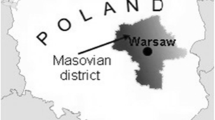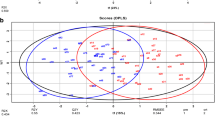Abstract
The lead, copper, zinc, and magnesium contents of scalp hair taken from 173 children aged 1–15 yr and young people (16–18 yr) with certain disorders of the osteomuscular articular system (osteomuscular pains of unknown origin, once described as “growing pains”) were measured, using the flame atomic absorption spectrometry method, and then compared with those of 108 normal, healthy children. The research showed increased average levels of lead (a statistically significant p<0.05 in both the overall group of children, and in those over 11 yr old), and zinc (increased in the total group, in a statistically significant way at p<0.10 only in adolescents over 15 yr old) and decreased levels of copper (although not significantly) in the hair of children suffering from “rheumatic” diseases, as compared with controls. The magnesium levels for the total group of ill children were admittedly enhanced, but in the youngest children, the levels were reduced.
The values of the Mg/Pb and Mg/Zn ratios were lower (in the youngest children, 70% decrease of the Mg/Pb ratio) and Zn/Cu were higher in the group of children suffering from rheumatic diseases than in the healthy children. The difference of Mg/Pb ratio between the total controls and rheumatic subjects was statistically significant at p<0.05 and the Zn/Cu at p<0.10. The Mg/Zn ratio was not statistically significant.
Similar content being viewed by others
References
W. Arnold and H. Sachs, Hair analysis for medicaments — the best proof for a drug career, Fresenius J. Anal. Chem. 348, 484–489 (1994).
A. Chatt and S.A. Katz, Hair Analysis. Applications in the Biomedical and Environmental Sciences, VCH, Weinheim (1988).
H. Kijewski and J. Lange, Die Beurteilung des Spurenelementgehaltes von Haaren in Kriminalistik, Toxikologie und Umweltschutz, Z. Rechtsmed. 80, 79–106 (1977).
P. Kintz, B. Ludes, and P. Mangin, Evaluation of nicotine and cotinine in human hair, J. Forensic Sci. 37, 72–76, (1992).
P. Kintz, A. Tracqui, and P. Mangin, Detection of drugs in human hair for clinical and forensic application, Int. J. Leg. Med. 105, 1–4 (1992).
P. L. Kirk, Hair, in Crime Investigation, J. I. Thornton (ed.), Wiley, New York, pp. 143–166 (1974).
L. M. Klevay, B. R. Bistrian, R. C. Fleming, and Ch. G. Neumann, Hair analysis in clinical and experimental medicine, Am. J. Clin. Nutr. 46, 233–236 (1987).
R. Higuchi, C. G. von Beroldingen, G. F. Sensabaugh, and H. A. Erlich, DNA typing from single hairs, Nature 332, 543–546 (1988).
M. R. Harkey and G. L. Henderson, Hair analysis for drugs of abuse, in Advances in Analytical Toxicology, R. C. Baselt, ed., Year Book Medical, Chicago, pp. 298–329 (1989).
G. Kauert and J. Röhrich, Concentrations of Δ9-tetrahydrocannabinol, cocaine and 6-monoacetylmorphine in hair of drug abusers, Int. J. Leg. Med. 108, 294–299 (1996).
D. A. Kidwell, M. A. Blanco, and F. P. Smith, Cocaine detection in a university population by hair analysis and skin swab testing, Forensic Sci. Int. 84, 75–86 (1997).
E. Klug, Zur Morfinbestimmung in Kopfhaaren, Z. Rechtsmed. 84, 189–193 (1980).
P. Kintz, (ed.), Drug Testing in Hair, CRC, Boca Raton, FL, (1996).
Ch. Girod and Ch. Staub, Analysis of drugs of abuse in hair by automated solidphase extraction, GC/EI/MS and GC ion trap/CI/MS, Forensic Sci. Int. 107, 261–271 (2000).
W. W. Benson and J. Gabica, Total mercury in hair in 1,000 Idaho residents — 1971, Pesticides Monitring J. 6, 80–83 (1972).
P. J. Nord, M. P. Kadaba, and J. R. J. Sorenson, Mercury in human hair. A study of the residents of Los Alamos and Pasadena by cold-vapour atomic absorption spectrophotometry, Arch. Environ. Health 27, 40–44 (1973).
I. B. A. Razagui and S. J. Haswell, The determination of mercury and selenium in maternal and neonatal scalp hair by inductively coupled plasma-mass spectrometry, J. Anal. Toxicol. 21, 149–153 (1997).
A. S. Curry and C. A. Pounds, Arsenic in hair, J. Forensic Sci. Soc. 17, 37–44 (1977).
D. Maes and B. D. Pate, The absorption of arsenic into single human head hairs, J. Forensic Sci. 22, 89–94 (1977).
H. Hagedorn-Götz and M. Stoeppler, Zum forensichen Nachweis von Thallium in menschlichen Haaren durch flamenlose Atomabsorptionsspektrometrie, Arch. Toxicol. 34, 17–26 (1975).
P. Grandjean, Lead poisoning. Hair analysis shows the calendar of events, Hum. Toxicol. 3, 223–228 (1984).
B. A. Revich, Lead in hair and urine of children and adults from industrialized areas, Arch. Environ. Health 49, 59–62 (1994).
K. Nishiyama and G. F. Nordberg, Adsorption and elution of cadmium on hair, Arch. Environ. Health 25, 92–96 (1972).
W. W. Harrison, J. P. Yurachek, and C. A. Benson, The determination of trace elements in human hair by atomic absorption spectroscopy, Clin. Chim. Acta 23, 83–91 (1969).
D. I. Hammer, J. F. Finklea, R. H. Hendricks, C. M. Shy, and R. J. M. Horton, Hair trace metal levels and environmental exposure, Am. J. Epidemiol. 93, 84–92 (1971).
G. F. Gordon, Sex and age related differences in trace element concentrations in hair, Sci. Total Environ. 42, 133–147 (1985).
S. B. Deeming and Ch. W. Weber, Hair analysis of trace minerals in human subjects as influenced by age, sex, and contraceptive drugs, Am. J. Clin. Nutr. 31, 1175–1180 (1980).
J. P. Creason, T. A. Hinners, J. E. Bumgarner, and C. Pinkerton, Trace elements in hair, as related to exposure in Metropolitan New York, Clin. Chem. 21, 603–612 (1975).
M. Marlowe, Ch. Moon, J. Errera, and J. Stellern, Hair mineral content as a predictor of mental retardation, Orthomol. Psychiatry 12, 26–33 (1983).
D. Maes and B. D. Pate, The spatial distribution of zinc and cobalt in single human head hairs, J. Forensic Sci. 22, 75–88 (1977).
G. D. Renshaw, The distribution of trace elements in human hair and its possible effect on reported elemental concentration levels, Med. Sci. Law 16, 37–39 (1976).
M. Oishi, T. Takasu, M. Tateno, and H. Uschida, Hair trace elements in cerebellar degeneration: low copper levels in late, cortical celebellar atrophy, J. Neurol. 237, 163–165 (1990).
V. D. Matera, V. A. Arbige, S. A. Tomellini, D. A. Erbe, M. M. Doxtader, and R. K. Force, Evaluation of wash solutions as a preliminary step for copper and zinc determinations in hair, Anal. Chim. Acta 124, 409–414 (1981).
T. Lech, Lead, copper, zinc and magnesium content in hair of children and young people with some neurological diseases, Biol. Trace Element Res. 85, 111–126 (2002).
T. Lech, Calcium and magnesium content in hair as a predictor of diseases in children. Part I. Neurological disorders, Trace Elements Electrolytes 18(3), 112–121 (2001).
T. Lech, Calcium and magnesium content in hair as a predictor of diseases in children. Part II. Disorders of the osteomusculararticular system, Trace Elements Electrolytes 18(4), 165–171 (2001).
G. Bagliano, F. Benischek, and I. Huber, A rapid and simple method for the determination of trace metals in hair samples by atomic absorption spectrometry, Anal. Chim. Acta 123, 45–56 (1981).
J. Chłopicka, P. Zagrodzki, Z. Zachwieja, M. Krośniak, and M. Fołta, Use of pattern recognition methods in the interpretation of heavy metals content (Pb, Cd) in children’s scalp hair, Analyst 120, 943–945 (1995).
T. Kozielec, I. Hornowska, L. Kotkowiak, and A. Sałacka, Study on lead and cadmium in the hair of children and young people, Bromat. Chem. Toksykol. 26, 293–296 (1993) (in Polish).
Z. Krejpcio, D. Olejnik, R. Wójciak, K. Kiełczewska, and J. Gawęcki, Assessment of the content of calcium, magnesium, zinc and copper in hair and serum of children with hyperactivity, Polish J. Environ. Studies 6(Suppl.), 89–92 (1997).
A. Chattopadhyay, T. M. Roberts, and R. E. Jervis, Scalp hair as a monitor of community exposure to lead, Arch. Environ. Health 32, 226–236 (1977).
B. Dudek, Toxicological effects of lead in children, Med. Pracy, 46(Suppl. 1), 101–113 (1993) (in Polish).
M. Schumacher, J. L. Domingo, J. M. Llobet, and J. Corbella, Lead in children’s hair, as related to exposure in Tarragona Province, Spain, Sci. Total Environ. 104, 167–173 (1991).
L. M. Klevay, Hair as a biopsy material. III. Assessment of environmental lead exposure. Arch. Environ. Health 26, 169–172 (1973).
M. Bergomi, P. Borella, and G. Fantuzzi, Sangue, denti e capelli: tre diverse matrici utilizzate per valutare 1[???]’esposizione al plombo e a cadmio in bambini residenti in zona industriale, Ann-Ig. 1, 1185–1196 (1989).
A. A. Golow, and E. E. Kwaansa-Ansah, Comparison of lead and zinc levels in the hair of pupils from four towns in the Kumasi Municipal Area of Ghana, Bull. Environ. Contam. Toxicol. 53, 325–331 (1994).
B. Nowak, Contents and relationship of elements in human hair for a non-industrialised population in Poland, Sci. Total Environ. 209, 59–68 (1998).
J. Durlach, Le Magnésium en Pratique Clinique, J. B. Bailliere, Paris (1985).
L. Wecker, S. B. Miller, S. R. Cochran, D. L. Dugger, and W. D. Johnson, Trace element concentrations in hair from autistic children, J. Mental Defic. Res. 29, 15–22 (1985).
M. Dastych and O. Vlach, Zinc status in patients with idiopathic scoliosis, Spine 15, 65–66 (1990).
K. A. Shrestha and A. E. Carrera, Hair trace elements and mental retardation among children, Arch. Environ. Health 43, 396–398 (1988).
Author information
Authors and Affiliations
Rights and permissions
About this article
Cite this article
Lech, T. Lead, copper, zinc, and magnesium levels in hair of children and young people with some disorders of the osteomuscular articular system. Biol Trace Elem Res 89, 111–125 (2002). https://doi.org/10.1385/BTER:89:2:111
Received:
Revised:
Accepted:
Issue Date:
DOI: https://doi.org/10.1385/BTER:89:2:111




